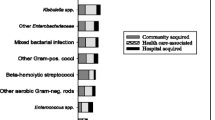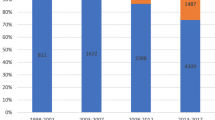Abstract
This study aimed to describe the epidemiology and antimicrobial resistance trends of Klebsiella pneumoniae bloodstream infection (BSI) in Ireland, in conjunction with national antimicrobial consumption data, during the period 2008 to 2013. A retrospective cohort study of K. pneumoniae BSI cases was conducted, based on notifications from Irish microbiology laboratories to the Health Protection Surveillance Centre (HPSC). In total, 1942 K. pneumoniae BSI cases were identified over 6 years, with 310 reported in 2008 and 326 reported in 2013. From 2008 to 2013, the proportion of isolates resistant to co-amoxiclav (24 % versus 29 %), piperacillin-tazobactam (11 % versus 27 %), third generation cephalosporins (3GC) (11 % versus 21 %), fluoroquinolones (13 % versus 21 %) and gentamicin (11 % versus 17 %) increased overall, concurrent with increasing national rates of antimicrobial consumption in Ireland (acute hospitals: 35.87 versus 39.77 defined daily doses (DDD) per 100 bed days used (BDU); and community: 6.38 versus 7.85 DDD per 1000 inhabitants per day (DID)). Enhanced data on the patient’s admission route was available for 735 (38 %) cases. Overall, 51 % (n = 378) were categorised as ‘acquired in the reporting hospital’. The all-cause mortality was 20 %, with 115 deaths, 101 (88 %) of whom died within 30 days of blood culture sampling date. K. pneumoniae is the second most common cause of Gram-negative BSI in Ireland, with most cases healthcare-associated and an all-cause mortality of 20 % reported in this study. Annual increases in resistance to different antimicrobial classes and in a multi-drug resistant phenotype have been observed, concurrent with increasing national broad spectrum antimicrobial consumption. These trends portend a risk to patient outcomes and highlight the urgency for individual prescribers to evaluate their antimicrobial prescribing habits in hospitals, long-term care and community settings.

Similar content being viewed by others
References
Public Health Agency of Canada. Klebsiella spp. [Online] 08 September 2011. http://www.phac-aspc.gc.ca/lab-bio/res/psds-ftss/klebsiella-eng.php. Accessed 19 April 2015
Ullmann U, Podschun R (1998) Klebsiella spp. as nosocomial pathogens: epidemiology, taxonomy, typing methods, and pathogenicity factors. Clin Microbiol Rev 11(4):589–603
Cabritaa J, Oleastroa M, Lopesb MM, Barrosa R, Peresc I, Piresa I (1995) Molecular epidemiologic analysis of multiresistant Klebsiella pneumoniae isolates from a pediatric hospital. Lisbon. Clin Microbiol Infect 5(2):109–112
Asensio A, Oliver A, González-Diego P, Baquero F, Pérez-Díaz JC, Ros P, Cobo J, Palacios M, Lasheras D, Cantón R (2000) Outbreak of a Multiresistant Klebsiella pneumoniae Strain in an Intensive Care Unit: Antibiotic Use as Risk Factor for Colonization and Infection. Madrid. Clin Infect Dis 30:55–60
ECDC, European Centre for Disease Prevention and Control (2013) Point prevalence survey of healthcare-associated infections and antimicrobial use in European acute care hospitals. ECDC, Stockholm
ECDC (2014) Annual Report of the European Antimicrobial Resistance Surveillance Network (EARS-Net) 2013. ECDC, Stockholm
ECDC (2015) Annual epidemiological report 2014. ECDC, Stockholm
Ko W-C, Paterson DL, Sagnimeni AJ, Hansen DS, Von Gottberg A, Mohapatra S, Casellas JM, Goossens H, Mulazimoglu L, Trenholme G, Klugman KP, McCormack JG, L-Yu V (2002) Community-acquired Klebsiella pneumoniae bacteremia: global differences in clinical patterns. Emerg Infect Dis 8(2):160–166
HSE - Health Protection Surveillance Centre (2011) SARI Prevention of Intravascular Catheter-related Infection Sub-Committee. Guidelines for the prevention of catheter-associated urinary tract infection. HSE, Dublin, Ireland
Tseng C-P, Wu H-S, Wu T-H, Lin Y-T (2013) Clinical characteristics and outcome of patients with community-onset Klebsiella pneumoniae bacteremia requiring intensive care. J Microbiol Immunol Infect 46:217–223
Marra AR, Wey SB, Castelo A, Gales AC, Cal RG, do Carmo Filho JR, Edmond MB, Pereira CAP (2006) Nosocomial bloodstream infections caused by Klebsiella pneumoniae: impact of extended-spectrum β-lactamase (ESBL) production on clinical outcome in a hospital with high ESBL prevalence. BMC Infect Dis 6:24
Tumbarello M, Viale P, Viscoli C, Trecarichi EM, Tumietto F, Marchese A, Spanu T, Ambretti S, Ginocchio F, Cristini F, Losito AR, Tedeschi S, Cauda R, Bassetti M (2012) Predictors of mortality in bloodstream infections caused by carbapenemase producing Klebsiella pneumoniae: importance of combination therapy. Clin Infect Dis 55(7)
HSE – Health Protection Surveillance Centre (2009) SARI Prevention of Intravascular Catheter-related Infection Sub-Committee. Prevention of Intravascular Catheter-related Infection in Ireland, Revised 2014. HSE, Dublin, Ireland
HSE, Health Service Executive (2012) Case Definitions for Notifiable Diseases. Version 1.2. HSE, Dublin, Ireland
CDC, Centers for Disease Control and Prevention (2013) Antibiotic resistance threats in the United States. CDC, Atlanta, GA
ECDC, European Centre for Disease Prevention and Control (2013) Annual Report of the European Antimicrobial Resistance Surveillance Network (EARS-Net) 2012. Stockholm
O’Brien DJ, Wrenn C, Roche C, Rose L, Fenelon C, Flynn A, Murphy V, FitzGerald SF, Fenelon LE, Crowley B, Schaffer K (2011) First isolation and outbreak of OXA-48-producing Klebsiella pneumoniae in an Irish hospital. Eur Surveill 16(29)
Prior AR, Roche C, Lynch M, Kelly S, O’Rourke K, Crowley B (2010) First identified case of VIM-producing carbapenem resistant Klebsiella pneumoniae in the Republic of Ireland associated with fatal outcome. Eur Surveill 15(50)
ECDC (2009) European Centre for Disease Prevention and Control - European Antimicrobial Surveillance System. EARSS Annual Report 2008. Stockholm
ECDC, European Centre for Disease Prevention and Control (2014) Summary of the latest data on antibiotic consumption in the European Union. Stockholm
ECDC, European Centre for Disease Control and Prevention (2014) Surveillance of antimicrobial consumption in Europe, 2012. Stockholm
SARI (2009) A Strategy for the Control of Antimicrobial Resistance in Ireland. Guidelines for Antimicrobial Stewardships in Hospitals in Ireland. Health Service Executive-Health Protection Surveillance Centre, Ireland
Health Service Executive. Guidelines for Antimicrobial Prescribing in Primary Care in Ireland. antibioticprescribing.ie. [Online] 2015. http://www.antibioticprescribing.ie/. Accessed 31 January 2015
Kang C-I, Kim S-H, Bang J-W, Kim H-B, Kim N-J, Kim E-C, Oh M-d, Choe K-W (2006) Community-acquired versus nosocomial Klebsiella pneumoniae bacteremia: clinical features, treatment outcomes, and clinical implication of antimicrobial resistance. J Korean Med Sci 21(5)
WHO, World Health Organization (2014) Antimicrobial Resistance. Global Report on Surveillance. WHO, Geneva
Mouloudi E, Protonotariou E, Zagorianou A, Iosifidis E, Karapanagiotou A, Giasnetsova T, Tsioka A, Roilides E, Sofianou D, Gritsi-Gerogianni N (2010) Bloodstream infections caused by metallo-β-lactamase/ carbapenemase-producing K. pneumoniae among intensive care unit patients in Greece: risk factors for infection and impact of type of resistance on outcomes. Infect Control Hosp Epidemiol 31(12)
Ben-David D, Kordevani R, Keller N, Tal I, Marzel A, Gal-Mor O, Maor Y, Rahav G (2012) Outcome of carbapenem resistant Klebsiella pneumoniae bloodstream infections. Clin Microbiol Infect 18(1)
Health Service Executive (HSE) – Health Protection Surveillance Centre (HPSC) (2015) Irish EARS-Net Steering Group. EARS-Net Report, Quarters 1-4 2014. Irish EARS-Net Steering Group, Dublin, Ireland
Holt KE et al (2015) Genomic analysis of diversity, population structure, virulence, and antimicrobial resistance in Klebsiella pneumoniae, an urgent threat to public health. Proc Natl Acad Sci PNAS 112(27):E3574–E3581
The European Committee on Antimicrobial Susceptibility Testing. Breakpoint tables for interpretation of MICs and zone diameters. Version 1.0, 1.1, 1.2, 2.0 and 3.1. http://www.eucast.org. Accessed 19 June 2016
van der Bij AK, van Dijk K, Muilwijk J, Thijsen SFT, Notermans DW, de Greeff S, van de Sande-Bruinsma N (2012) Clinical breakpoint changes and their impact on surveillance of antimicrobial resistance in Escherichia coli causing bacteraemia. Clin Microbiol Infect Control 18:E466–E472
Acknowledgments
Sincere thanks to the staff of all microbiology laboratories who report enhanced EARS-Net data in Ireland.
Author contributions
Melissa Brady performed the analyses. Robert Cunney and Karen Burns initiated the research. All authors supported the analyses and approved the final submitted draft.
Author information
Authors and Affiliations
Corresponding author
Ethics declarations
A retrospective study was conducted in accordance with the ethical standards of the national centre for surveillance of infectious diseases in Ireland and with the 1964 Helsinki declaration and its later amendments or comparable ethical standards. For this type of study formal consent is not required.
Funding
No funding was received for this work.
Conflict of interest
The authors declare that they have no conflict of interest.
Rights and permissions
About this article
Cite this article
Brady, M., Cunney, R., Murchan, S. et al. Klebsiella pneumoniae bloodstream infection, antimicrobial resistance and consumption trends in Ireland: 2008 to 2013. Eur J Clin Microbiol Infect Dis 35, 1777–1785 (2016). https://doi.org/10.1007/s10096-016-2727-4
Received:
Accepted:
Published:
Issue Date:
DOI: https://doi.org/10.1007/s10096-016-2727-4




